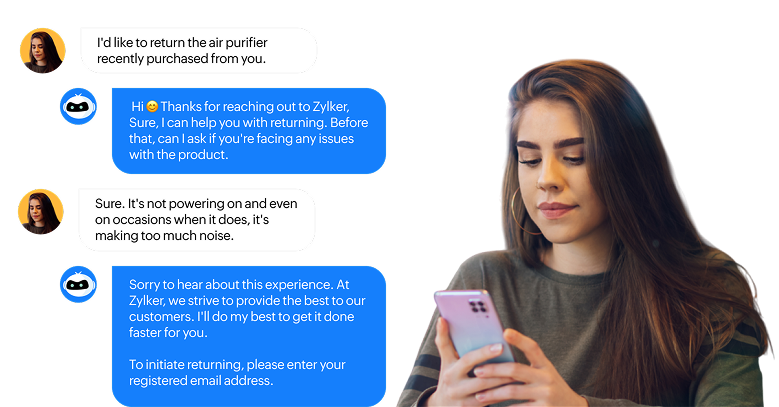FAQs on conversational AI examples and use cases
How customizable are conversational AI systems to match my brand voice and tone?
Conversational AI is highly customizable to match your brand voice and tone. The AI system can be trained with your brand's content—like your website content, landing pages, decks, emails, support replies, and more—to make the AI identify and understand the tone, language style, and response behavior. Conversational AI can also be trained by setting negative rules—the way you don't want the AI to behave. It'll further help the system understand how to match your brand's voice and tone.
What is the cost of deploying a conversational AI solution compared to hiring more human agents?
There is an upfront cost to purchase/build and set up a conversational AI solution, and businesses need to pay the operating cost to run it. Human agents incur costs for recruitment, training, salaries, benefits, upskilling, and the like. But what distinguishes conversational AI from human agents is its scalability and multi-tasking ability.
A report by Invesp4 states that businesses can save up to 30% of their costs by using chatbots.
What KPIs should I track to measure the success of conversational AI?
Some metrics businesses can monitor to measure the success of conversational AI are:
- Response rate: i.e., the time taken to provide the first response
- Deflection rate: % of queries deflected to human users without providing resolution
- Resolution rate: % of queries resolved by the conversational AI without any human intervention
- Customer satisfaction scores (CSAT): Customers' experience with the conversational AI
What ROI can I expect from implementing conversational AI in customer support or sales?
1. Reduced operational cost and can be scaled: Because the conversational AI chatbots will take care of half your support volume and act as your virtual sales assistant, your teams can achieve a lot more without increasing their headcount. It leads to increased revenue, satisfied customers, and reduced operational costs.
2. Saved time and effort: Your customer support and sales teams can focus on highly critical tasks that require hyper-personalization and leave the repeated, usual affairs to the conversational AI. This will help them save time and effort and allow them to focus on maximizing their output.
3. Increased customer trust and loyalty: Conversational AI's instant responses, personalized recommendations, zero waiting time, and better resolution rates will help you earn your customers' trust and loyalty.
How does conversational AI handle complex, multi-turn conversations?
To handle multi-turn conversations, conversational AI has:
Context management system: It tracks the context of the conversation to understand the flow and ensures the chatbot doesn't go out of context during the multi-turn conversations.
Intent recognition: It understands why the user is asking such questions and decrypts the intent behind the queries. It ensures the answers provided satisfy the purpose.
Memory and state tracking: This system acts as a memory and storage unit and helps conversational AI remember all the crucial details throughout the conversation.
Fallbacks and escalation: No system is perfect, and this applies to conversational AI as well. When the system isn't able to provide a satisfactory resolution, it escalates the conversation to the available human.

